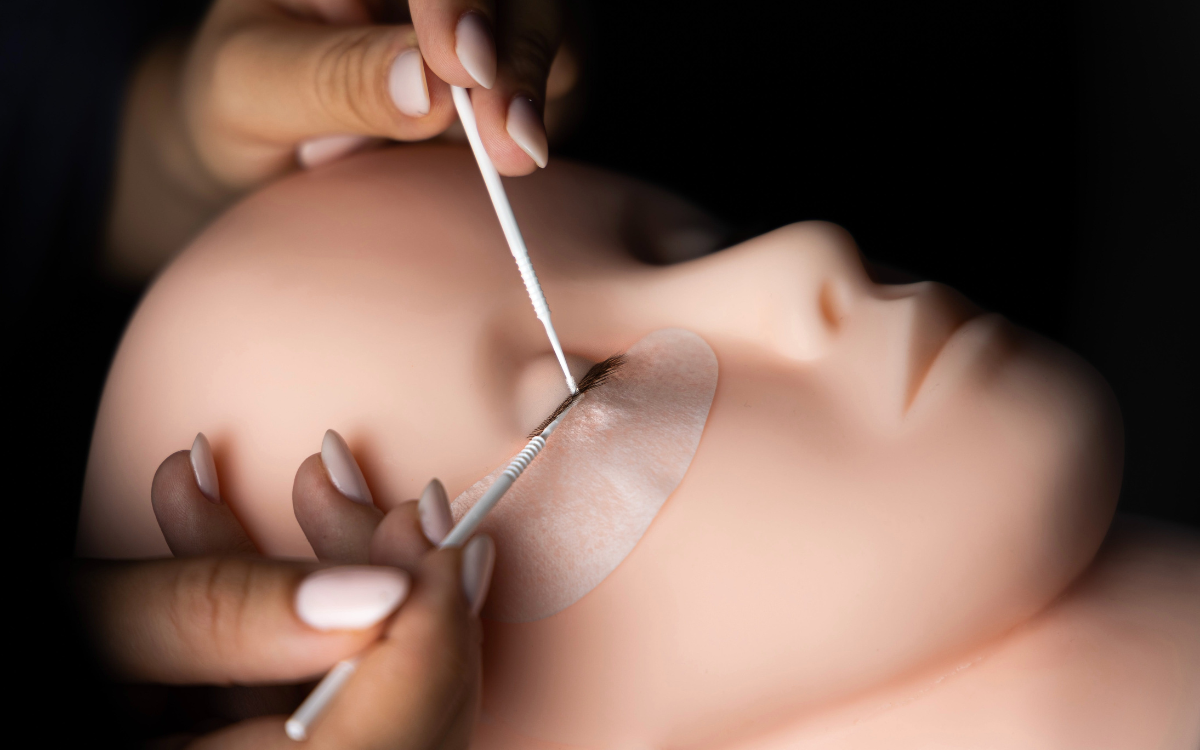Flared. Fluttery. Fanned-out. That is the aesthetic that you want to achieve with your clients' lash extensions! It is entirely unacceptable to have clumpy lashes, not just because of how they look but also because of the potential damage they might bring to the lashes.
This post is for you if you've observed that your clients' lash extensions look clumpy or glued together often. I'll explain how to prevent clumping of lash extensions and assist you in figuring out what the underlying issues may be (hint: it might have been their previous lash stylist!).
Let's plunge in!
Why Do Lash Extensions Get Clumpy?
There are a lot of possible explanations for why the lash extensions are starting to bunch up. Sadly, the most common one we run against is an inefficient application technique on the technician's part.
Before applying any extension lashes to any of your client's natural lashes, you must carefully separate each and ensure they are in great condition. Only then may they attach the extension lashes. Clumping, which we also refer to as "stickies," happens when the isolation is not as good as it should be, which results in one extension becoming connected to more than one natural eyelash.
Only a handful of potential explanations exist for why your extensions would ever bunch together. Let's take a look at each one on its own, and we'll explain how you may deal with the problem:
The Application of the Lash It Didn't Go According to Plan
The application of false eyelashes incorrectly can frequently result in clumped lashes, particularly if the person who applied them did not carefully attach each extension to its corresponding natural lash. This issue often arises due to lash extensions that the patient has used, and the reason for this is straightforward to grasp. Clients will have difficulty applying for these extensions independently, and it is too simple to wind up with one extension adhered to numerous lashes or vice versa. So, what exactly is the response?
They should go to a lash extension salon that is reputable and experienced if they want to prevent having a botched procedure. Qualified lash technicians have the education and experience to guarantee that your application will be carried out correctly every time.
Mascara has caused the extensions to stick together.
Mascara can also be problematic since it can result in a greasy appearance that causes the lashes to clump together in an unpleasant and often painful manner. This can be avoided by avoiding using too much mascara. The truth is that clients usually won't need to use mascara once they have new lash extensions. Nonetheless, if a client feels the need to put on mascara, they should follow these straightforward instructions:
- Always choose brand-new mascara rather than using old, crusty makeup.
- Deliberately apply the mascara, working your way outward from the brush.
- Wait until the first coat is completely dry before even considering applying a second.
The Eyelashes Have a Curl to Them
The technician may counsel the client to avoid sleeping on the face because extensions can become curved while sleeping. Naturally, this can sometimes be difficult to prevent; therefore, the question arises: what should clients do if their extensions bend into one another? Initially, they should try to straighten them so they can regain their natural curl gently. If it doesn't work, they might have to go back to the salon and talk to the technician there to see if they can come up with another solution.
But, if clumping only becomes an issue a few days or weeks after you get your extensions done, there may be something wrong with their aftercare routine. The accumulation of oil or a lack of brushing can cause momentary clumping.
Are Clumpy Eyelashes an Expected Result of Eyelash Extensions?
Nope.
When we do certain types of lash extensions, such as hybrid and volume extensions, we glue many lash extensions onto a single natural lash. This creates a look that some people could characterize as clumpy. These are referred to as "volume fans," and they are in every way what we intend to achieve.
Remember that adding several extensions to a single natural eyelash is perfectly acceptable. When one or more extensions are linked to more than one of a person's natural lashes, this creates an issue (not perfectly isolated).
There are a few variations of lash stickies
- Baby lashes sticking to an extension
The smallest baby lash often gets caught on an extension, creating the first stickie type. One of the most widespread varieties of sticky notes is this kind. Why?
Often the baby lashes are the most difficult to do since they are so short and difficult to isolate. In addition, the growth rate of infant lashes is far faster than that of fully developed lashes in their "resting period."
If a baby lash becomes entangled with an extension, the baby lash will continue to grow. It may push the extension lash to the side, resulting in an extremely unattractive appearance. Never discount the power of these teeny-tiny baby lashes.
- An extension lash sticking to another extension
This can occur when using an excessive amount of adhesive. When using excessive glue, the adhesive's drying time can be slowed, resulting in the bond appearing lumpy.
Stickies of this type might present a significant challenge when filling in gaps. Thus, ensure that you apply the appropriate amount of glue to your sets and maintain the position of the isolation tweezers until the glue has completely dried.
- The bottom lashes stick to the upper lash.
This can occur if the under-eye pad is not properly positioned to hold the lower lashes in place (or tape). Because of this, the lower lashes have a greater tendency to fall out throughout the session and become entangled with the higher lash extensions.
When you finish the set before you ask the customers to open their eyes, lift their eyelids slightly and inspect to ensure that their upper and lower lashes have not become entangled.
How to prevent lash stickie?
Choosing the right eyelash extension glue
Stickies are sometimes the result of using glue that dries too slowly. A fantastic method for avoiding lash stickie is using an adhesive with a fine texture that dries quickly.
If you are working with a type of glue that dries more slowly or is more viscous, you may need to keep the isolation tweezers in place for a few seconds to ensure the glue attaches properly. This is an excellent method for lowering the possibility of developing a lash stickie.
Use the right amount of lash glue.
It is important to avoid getting a ball of glue on the extension! Using additional glue will not result in a longer retention time. Dip the extension into the glue dot's middle, then slowly slide it out. This will ensure that you are using the appropriate quantity. You should have a thin layer that extends up 2 millimeters from the base of the lash extension.
It is possible to end up with excessive glue on the extension if you pull away from the glue dot too soon, scoop the glue with the extension, or skim across the glue dot.
Do not use a glue palette or gel pads to remove excess glue from an extension when too much glue is already on the extension. To remove the extension, simply slide it out slowly after dipping it into the middle of the adhesive dot. It will regulate itself to the appropriate level of adhesive.
How to Keep Lash Extensions from Clumping?
- Cleaning it often
Let's get the fundamentals out of the way first. Clients need to remember to clean the lash extensions regularly because failure can lead to various complications with lash extensions. In that case, a buildup of oil and debris could cause the extensions to become adhered to one another.
As a lash artist, you should instruct your clients to prevent it from clumping.
- Using the correct cleanser
Check to see that the clients are utilizing the appropriate cleanser. They are strongly recommended to use a lash shampoo designed specifically for cleaning lashes, but they can also use face wash, micellar water, or baby shampoo. They must avoid any cleaners that contain oil or alcohol because these substances can potentially make the adhesive less effective.
- Using a brush to clean them
When clients clean their lash extensions, we strongly suggest they use a brush designed specifically for them or a fluffy, ultra-soft eyeshadow brush. When they use their fingers to wipe their eyelashes, they won't get a thorough cleaning, and cotton pads can pull on the lashes or leave a residue behind.
- Combing them
Combing eyelash extensions is the quickest and easiest technique to prevent them from clumping together and guarantee that they appear fluffy and full. After ensuring that the lashes are completely dry, run a spoolie that has been thoroughly cleaned through them a few times. It is important to remember that this will only be successful if they are just momentarily entangled or stuck together.
- Sleeping carefully
The lash extensions could become damaged if they sleep on their stomach or pull the covers over their head and face. Most of the time, bad sleeping habits are to blame for lashes ripped off, bent out of shape, or clumped together; however, this is not always the case.
Always sleep on the back, and do not pull the covers higher than the chest. Clients can even buy specialized pillows to assist them with their sleeping position, or they can try using a domed eye mask while they sleep to protect their eyelashes. All of these options are available.
Final Thoughts
Allow a few minutes after the treatment to double-check that you haven't missed any lash stickies.
Using your tweezers, examine each lash from root to tip. If there are any stickies, separate them. Ask your client to blink several times and roll her eyes in different directions to discover whether she feels uncomfortable.
Checking stickies may appear time-consuming, but we assure you it is not. It's time well spent!
The customer's safety is always a top priority for their health and job.







